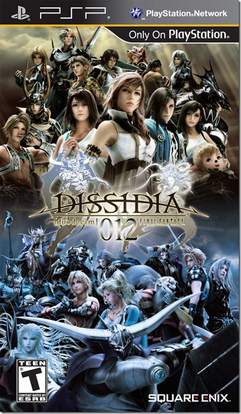Setting and characters
The game's main story revolves around the twelfth cycle of the eternal conflict between the gods Cosmos and Chaos, who have both summoned several warriors from different worlds [9] to fight for them in "World B", a mirror dimension to the realm of World A. [10] It features the entire cast of the original Dissidia with new and tweaked abilities, and introduces nine new playable characters for a total of thirty-one. Six of the new characters are available from the start of the game: Lightning, a former soldier and the protagonist of Final Fantasy XIII ; Vaan, a sky pirate and the protagonist of XII ; [6] [7] Laguna Loire, the man who appears in Squall's dreams and the secondary protagonist of VIII ; [7] Yuna, Tidus's love interest and female protagonist of X ; [11] [12] Kain Highwind, Cecil Harvey's childhood friend and rival from IV ; [13] and Tifa Lockhart, Cloud Strife's childhood friend from VII . [7] [13] The remaining three characters, which can be unlocked through various means of gameplay, are Prishe, a supporting character from Final Fantasy XI ; Gilgamesh, a recurring villain from Final Fantasy V ; and Feral Chaos, [b] an alternate form of Chaos. Final Fantasy VII's Aerith Gainsborough was available as an assist-only character (i.e. not fully playable in the game) through the purchase of Dissidia 012 Prologus Final Fantasy on the PlayStation Network. [14]
Story
During the twelfth cycle, the war is turning in favor of Chaos. Therefore, Cosmos entrusts her warriors with the task of retrieving the crystals that will help them defeat Chaos. [15] However, Cosmos does not foresee Chaos's forces employing an unworldly army of crystalline soldiers known as Manikins, which pose a threat due to their ability to negate the gods' power to revive the warriors after they are killed. [16] Believing their defeat to be inevitable, Kain and the Warrior of Light defeat most of their own allies to stop them from fighting the Manikins and return in the upcoming cycle. [17] Lightning opposes this plan and leads the other active warriors—Vaan, Yuna, Laguna, and Tifa—to stop the Manikins once and for all by sealing the portal from which they emerge, with Kain eventually joining them as well. [18] Though they succeed, Cosmos is reduced to a weakened state after using much of her power to diminish the Manikin army when they attempt to kill her and the Warrior of Light, [19] while Lightning and her group succumb to the Manikins' power and fade away. [20]
From there, the game retells the events of Dissidia Final Fantasy where returning warriors for Cosmos participate in the thirteenth cycle that ends the conflict between the gods. Once completing the thirteenth cycle, the player also has access to the third and final arc "Confessions of the Creator", in which Shinryu—a powerful entity that absorbs the warriors' memories and experiences following each cycle—traps Cosmos' comrade, Cid of the Lufaine, in a nightmare world where the cycles never end as punishment for saving Cosmos' warriors from the thirteenth cycle following Chaos' defeat. The player selects five characters to fight Feral Chaos, a stronger incarnation of Chaos, and save the imprisoned Cid from the nightmare world. [21] [22]
In addition to the main story is a set of "Reports", most of which follow the other warriors who participate in the thirteenth cycle, explaining their roles before and during that cycle. Prominent characters in these reports include warriors of Cosmos—Terra, Cloud and Tidus—who fight for the side of Chaos during the twelfth cycle, and Chaos's warrior Jecht, who appears on the side of Cosmos, with the reports detailing how these characters came to switch sides. Furthermore, the Reports cover other events such as how the Warrior of Light enters the conflict and meets Cosmos's previous warriors Prishe and Shantotto, along with Gilgamesh's misadventures upon stumbling into World B.

